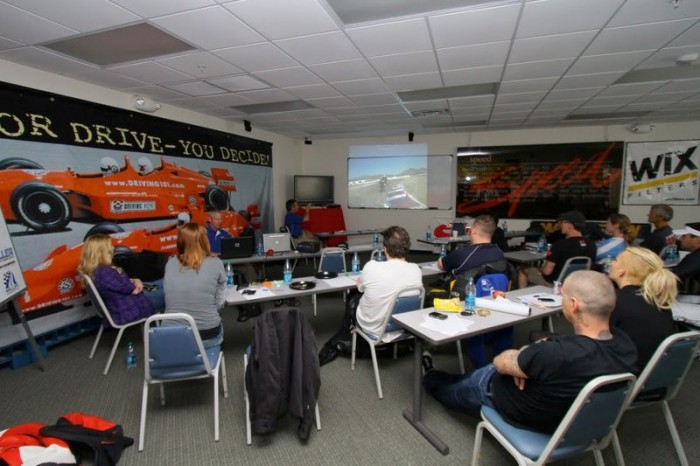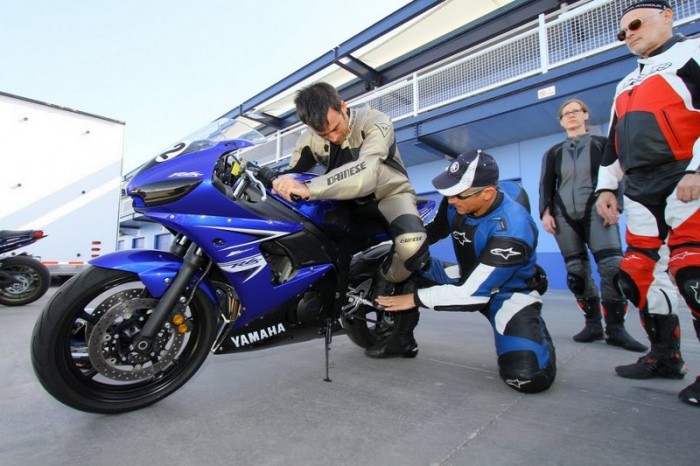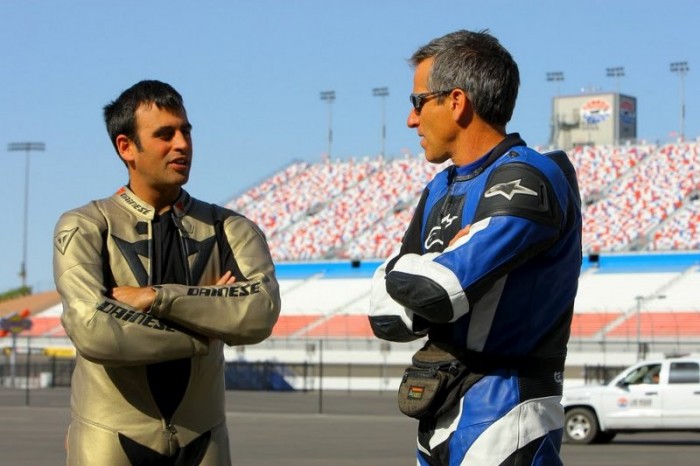
Clothes may make the man, but riding a motorcycle fast can’t be faked. You’re either fast on the racetrack or not, and being a fast guy (or girl) probably means you’ve crashed a lot … your skills learned in the school of hard knocks. That’s what I thought, anyway, until two days in Las Vegas with the Yamaha Champions Riding School showed me how wrong I was-and how little I know.
The YCRS is one-half of the phoenix that rose from the ashes of the Freddie Spencer High Performance Riding School when it abruptly shut down in October of 2008. Honda came with a big truck and took back its toys, and instructors Nick Ienatsch (say “eye-notch”), AFM/AMA uber-fast guy Ken Hill, Shane Turpin and Dale Keiffer were left without a roost. Another Spencer acolyte, Jeff Haney, took the opportunity to develop Spencer-esque curricula at the Skip Barber Superbike School in Laguna Seca, while Ienatsch, Hill and other instructors got hired on by Miller Motorsports Park to form the Yamaha Champions school. It’s a true heir to the well-known Spencer program, with the same instructors, tracks (Las Vegas Motor Speedway in the winter, Miller in Utah the rest of the year) and similar technique. A major change, of course, is the presence of a fleet of shiny new Yamaha sportbikes, including the YZF-R6, YZF-R6S and a few FZ-1s for the big guys.
I’m not one to shell out bread for racetrack instruction, as I’m a) broke and b) a cheapskate, but luckily for institutions like the YCRS, enough enthusiasts see the value to keep the classes full. The other students were an interesting and diverse bunch, including a local realtor, a pair of trackday enthusiasts and instructors from the Midwest, a Polish woman back from a Daytona club-race victory, and X-Games BMX star Chad Nagy. Nagy wasn’t even the most glamorous attendee; that was clear when Miss February 2003, Charis Burrett, and her clothing-magnate husband Luke rolled up like rock stars-complete with entourage and de rigueur reality-show camera crew-in a very expensive-looking Bentley. Luke had been riding about 15 years and has a Yamaha YZF- R1, but had yet to do a trackday. Charis had been riding but a month and 200 miles on a new R6 and was taking the school to “show that a girly-girl in high heels can go from not knowing anything to knowing how to ride.” Quite a group.
Quite a group, but for Nick Ienatsch (his name is Swiss, if you’re wondering), celebrity status means nothing. There is a right way to go fast and a wrong way, and even if you win races at the highest level, it doesn’t mean you don’t have something to learn. This becomes apparent as we look at photos and video of famous racers and Hill and Ianatsch examine body position and other technique. “If Toseland came here we could help him.”
If you’re not an A-list celebrity and have no Gulfstream to fly you to Miller, here is the program in a nutshell: body position, trail braking and perfect apexing. Like I learned last year at Skip Barber, without a good body position-head low to the inside of the bike, weight on the inboard footpeg, arms loose and knee out-you will need more lean angle and spend more time on the sides of your tires to go through a corner. That means you’re less safe, and worse, slower. Trail braking is key to hitting the apexes neatly and precisely, but it requires much finer control than most sportbikers exercise: sounds like the basis for many, many skill-building drills and exercises, right?

True, and the two multi-configurable racetracks at the Motor Speedway are perfect for this. No high-speed banking for this class; instead, we get one day on the infield course and a day on the outside road course. With no elevation changes and short straights, the two courses still offer a good mix of all the turns one might find at any racetrack.
By the end of the first session of day one, I know just how much I suck. I know it’s wrong, but my body position has reverted so that instead of looking like a GP star, I look like a spider monkey clinging to a rock, with my body angled away from the ground and my head over the middle of the bike in turns. Even though I’m among the faster riders, I still miss apexes, rush my corner entrances, and generally look like a jackass. Hill follows me with a video camera, and reviewing the footage is painful. Nick tells us that a perfect body position leads to perfect apexing, which will lead to lower lap times and even-can it be so?-the absence of crashing. The best racers and the best riders don’t crash. They don’t crash because they are doing it right. That realization, that there truly is a right way to do this, is revelatory.
The evidence is rubbed in my face over the two days. Kat Zimpel is the young woman who is measuring her Florida home for her Daytona CCS trophies. It turns out that she just started riding-not racing, riding-a year ago. Last year, she took the YCRS several times and over the winter prepared for the Daytona event, taking home two first-place trophies in two CCS classes. Sure, racing a brand-new Bimota DB5 against Suzuki SV650s probably didn’t hurt her chances, but it was her first race. Riding with her, I see the advantages of not teaching yourself how to ride: her body position is perfect and she neatly touches every apex. And it’s the same with Charis: she’s riding better, faster, and with less fear than 70 percent of the guys you’ll see trolling the hills on their sportbikes any given Sunday. Guys who’ve been riding for years, decades. And realtor Mark Boedekker is scary-fast, but how he goes fast is what’s remarkable: he hits each apex just so, gets on the throttle at just the right time, and exhibits smooth competence with each control movement. It’s obvious what’s key: body position. It’s also obvious why so many of the students are taking the class for the second, third, fourth (or more!) time: it takes time to erase old, bad habits and learn new, good ones.

The high instructor-to-student mix is key to getting those good habits. No matter where you are on track, an instructor is right there, watching you. You’re blazing along, passing all the other students, thinking what a cool moto-journo you are, grinding the little Dainese logos off your kneesliders, when lanky ol’ Ken Hill passes you on his FZ-1, one hand off the bar, turned in his seat, motioning you to drop your head, open up your shoulders to the inside of the turn. And when you stop for a break, the honest rebukes come. No! The instructors tell you. You are not cool. You cannot ride like that. You are asking for it. As proof of that, may I offer as evidence the scars, scabs and stories the male students in the class wave about like campaign ribbons? But now, instead of chuckling at the “I highsided to the moon” and ” I knew I was going down” stories as inevitable stops on the road to fast-guy-dom, I see them as proof that unless we’re riding perfectly and never crashing, we have much to learn.
And learn we do. Everybody in the class is surprised by how much they have improved, how much faster, smoother and in control they feel. “I’m more confident going faster,” says Charis. “Man, I’m really learning a lot,” says her man Luke (and he did learn a lot: I saw him struggling just to stay on track the first day, but he is noticeably more in control by the second day). I pick up a renewed faith in trail braking, something I had stopped doing since I started coaching the MSF Basic Rider Course last year. I also learn how sensitive and responsive a sportbike’s controls can be during Hill and Ienatsch’s useful drills.
Two days at YCRS gave me plenty of track time, and more information about racetrack technique than I could absorb with my hardened, de-crenelated brain. Tuition (in the mid-$2000 range) is high, but it includes some excellent equipment (leathers are available for rental, and transportation from your hotel is provided, so all you need to do is fly in), lunch, and expert coaching from some of the best instructors in the business. Hill and Ienatsch really love their work and know it helps, and that comes through: every exercise, drill and classroom lesson seems fresh and new, like they’re learning along with you. Their enthusiasm for the sport, even after decades around racetracks, is at a very high level.
Am I saying you need to book a flight and buy a space in the school right away? Well, it wouldn’t be the worst use of your money, and a lot of you have spent more dosh on carbon-fiber dress-up bits or flat-panel TVs. But what’s more important is that you learn how to ride from somebody who can demonstrate the proper technique. Not a fast guy who either crashes or wins, or the street rider with the biggest pair of nuts and the most screws in his collarbones. I found I felt most in control when my corner speeds were down and my body position was right, even if I found myself going slower. That tells me I have a lot to learn; maybe you do too.
Yamaha Champions Riding School offers classes around the country:go to the YCRS website for details. Nick Ienatsch’s book Sportbike Riding Techniques is a must-read and is available where book-like objects are sold.
Gabe Ets-Hokin is Editor-in-Chief of CityBike magazine, America’s 47th-most popular print motorcycling publication after Maduras Illustrated but before Fondue Touring. For subscription information, please drop an email to info@citybike.com.

Ienatsch warns Gabe about wearing Gold Lamé in the pits .. even in Vegas






Excellent. I took the Spencer class a few years ago and loved it. Nick was a great lead instructor. I’ve been to Las Vegas MS, but not to Miller, so I’ll try to get up there to take the class in the next year.
Great piece! Keep up the good work.